|
|
 |
|

|
| THE PHILIPPINES IN SO.EAST ASIA |
Welcome to The
At the very core of the heart of Southeast Asia lies a group of 7,107
"Island Worlds" that make up the 2nd largest archipelagaic nation
in the world known as the "Pearl of the Orient"- the Philippines.
|
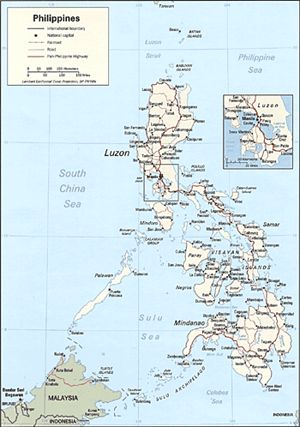
|
| MAP OFTHE PHILIPPINES |
|
Geographically, the Philippines' capital city of Manila lies at 14 degrees 35-minutes North-latitude,
and 121 degrees East-longitude, or some 8 hours ahead of Greenwich Time. The entire country
consists of three (3) major divisions, namely: the island of Luzon; in northern Philippines; the Visayas group of islands in Central Philippines; and the large island of Mindanao.
Politically, the nation has been subdivided into 16 Regional Areas comprising of some 76
different Provinces all throughout.
Historical accounts reveal that the country was officially "re-discovered" for Europe by the Portuguese
explorer FERDINAND MAGELLAN in 1521- through the generosity of the Spanish Crown that initiated the expedition
which also provided the first indisputable proof that the world is round. Prior to this, however, archeological
artifacts discovered around the country provide ample evidence to the existence of early Philippine civilization
which was engaged in trade and commerce with other neighboring Asian countries.
The year 1565 marked the beginning of the Spanish colonization of the Philippines- an era that endured for
the next 300 years until the coming of the Americans in 1898.
|
|
 |
|
|
|
|
|
|
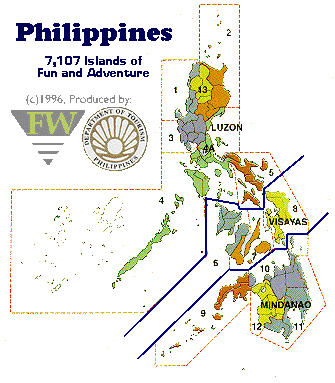
|
| REGIONS OF THE PHILIPPINES |
|
|
|
INTERESTING FEATURES & ASPECTS OF THE COUNTRY
|
|
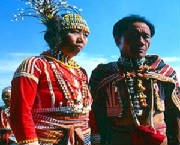
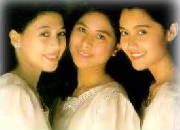
|
Some 80-million of them- and still growing! The Philippines currently ranks as the 12th most populous country in
the world- with a population of some 89-M (2006), roughly 10 percent of which are "scattered" althroughout the world.
And- not only are they one of the friendliest, but are also considered to be one of the "happiest" group of people in
the world! The people of the Philippines are called Filipinos. Most Filipinos are descended from the various Austronesian-speaking migrants who arrived in successive
waves over a thousand years ago from Southeast Asia. These ethnic Filipinos are divided into various ethnolinguistic groups, the three most numerous being the Tagalogs, Cebuanos, and the Ilocanos. They are genetically
closely related to the Taiwanese aborigines, Malays of Malaysia and Indonesia, and the Polynesians. The Negritos or Aetas are known as the aboriginal inhabitants of the Philippines, and number less than 30,000 people (0.03
percent).Filipino mestizos, or persons of mixed indigenous heritage and Spanish or other foreign ancestry form a tiny but economically
and politically important minority. A Stanford University small-in study, concluded that less than about 3.6 percent of all Filipinos have some European
genes..Other significant minorities include the ethnic Chinese, the Americans, and the South Asians.
|
|
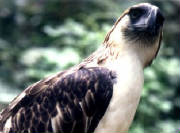

|
The Philippines is home to a myriad of wildlife- both flora and fauna, in this part of the planet.
|
|
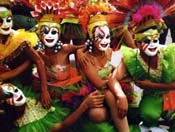
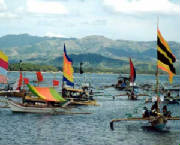

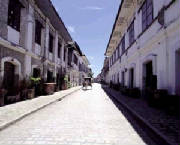
|
Nearly more than 300 years of Spanish rule and half a century of American influence have greatly shaped the interesting
"culture" of the Filipino people.
According to the Wikipedia Free Enclyclopedia..."Filipino culture is largely a blend of the indigenous traditions of
the Philippines, with the Hispanic and American cultures. It has also been significantly influenced by Chinese, Indonesian and Indian cultures.The Hispanic influences in Filipino culture are largely derived from the culture of Spain and Mexico as a result of over three centuries of Spanish colonial rule through Mexico City. These Hispanic influences are most evident in Roman Catholic Church religious festivals.Filipinos hold major festivities known as barrio fiestas to commemorate their patron saints. The most obvious Hispanic legacy, however, is the prevalence of Spanish surnames among Filipinos. This peculiarity, unique among the people of Asia, came as a result of a colonial decree for the systematic
distribution of family names and implementation of the Spanish naming system on the inhabitants of the Philippines. A Spanish surname in the Phillipines doesn't denote a Hispanic
heritage.The Chinese influences in Filipino culture are most evident in Filipino cuisine. The prevalence of noodles, known
locally as mami, are a testament of the Chinese cuisine. Other Chinese influences include linguistic borrowings and
the occasional Chinese derived surnames.The use of English within the Philippines is America's most obvious legacy. The most
commonly played and arguably the national sport in the Philippines is basketball. Indeed, there is a wide emulation of other American cultural trends, such as the love of fast-food; many street corners boast fast-food outlets. Aside from the American commercial giants such as McDonald's, Pizza Hut, Burger King, KFC, and Shakey's, local fast-food chains have also sprung up, including Jollibee, Greenwich Pizza, Tropical Hut and Chowking. Filipinos listen to American music, watch American movies, and admire American actors and actresses,
although Asian trends and culture began making inroads to the locals.In spite of this, native moral codes, respect of family, veneration of elders, and friendliness, all remain intact. Filipinos
honor national heroes whose works and deeds contributed to the shaping of the Filipino nation.
|
|


|
The Philippines is a land of "a thousand events".... cultural fiestas and national festivals!
|
|
 |
|
|
 |
|
|
 |
|
|
|
|
DISCLAIMER:
AdventureTravel-Philippines, one
of the major Programs being operated by xxxx and duly represented by its author, disclaims any and all responsibility
or liability for the accuracy, content, completeness, legality, reliability, or operability or availability of information
or material, or any responsibility for the deletion, failure to store, misdelivery, or untimely delivery of Messages, in
this website.
It
further disclaims any responsibility for any harm resulting from downloading or accessing any information or material
through the website.
AdventureTravel-Philippines.tripod.com web site and the information
contained therein, are provided on an "as is," basis, and the Author hereby disclaims all warranties or
conditions of any kind (whether express, implied or statutory), including without limitation the implied warranties of title,
non-infringement, and fitness for a particular purpose. Without limiting the foregoing, AdventureTravel-Philippines.tripod.com
does not promise or warrant to you that any aspect of the web site and system will work properly or will be available continuously.
NO LIABILITY:
In no event shall the Author be liable to any party for any loss or damage, including but not limited to lost
revenues or profits or special, indirect, incidental or consequential damages (howsoever arising, including negligence) arising
out of or in connection with this website.
TEXT
& PHOTO MATERIALS: Unless otherwise noted, all text
information and related links are those of Wikipedia Free Encyclopedia and likewise, photographs and
illustrations viewed herein this website have been provided courtesy of the Department of Tourism and allied-Agencies
for promotional purposes.
|
A HomeBased Travel Company * 201 cor. N Laurel & E Arch Streets * Fleetwood
* PA * 01234, U.S.A.
Copyright 2006 (c) All Rights Reserved
|
|
|
 |

